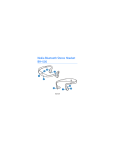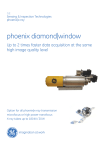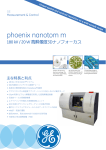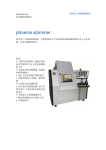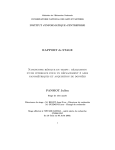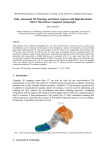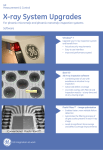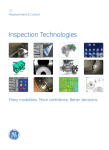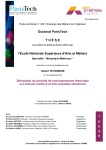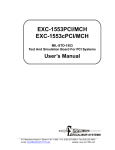Download GE phoenix microme|x Brochure
Transcript
GE Sensing & Inspection Technologies A GUIDE TO THE INSPECTION AND ANALYSIS OF ELECTRONIC PACKAGES with phoenix|x-ray microfocus and nanofocus X-ray systems FAQs about X-ray How X-ray inspection source large FOD works object FDD detector high magnification low magnification insulator UH cathode (filament) UG UACC grid anode magnetic lens electron beam deflection unit X-ray starts with a sample being irradiated by an X-ray source and projected onto a detector. The geometric magnification M of the image is the ratio of focus-detector distance (FDD), Focus-object distance (FOD): M=FDD/FOD. The smaller the focal spot, the greater the resolution. With the nanofocus technology a unique detail detectability down to 0.2 microns can be achieved. phoenix|x-ray systems reach geometric magnifications over 2 000 x resulting in total magnifications beyond 24 000 x. How X-ray tubes What makes an excellent work X-ray? The heart of the X-ray machine is an elec- In addition to resolution, maximum voltage, trode pair consisting of a cathode, the fila- and power, stability is very important for ment, and an anode, that is located inside a reliable results and highest up-time. One of vacuum tube. Current is passed through the phoenix|x-ray’s key techno-logy competen- filament heating it up, causing the filament cies are tube design and manufacturing. to emit electrons. The positively charged target anode draws the electrons across the tube. X-ray beam Unlike with conventional X-ray tubes, the electrons pass through the anode into a specifically designed set-up of electromagnetic lenses, where they are bundled and directed Why can the collision onto a small spot on the target, a flat metal protection be deactivated? the electrons collide with the target, they in- disc covered by a layer of tungsten. When 0.50 dose rate variation [%] small FOD dose rate stability XS|160 T 0.25 0.5% 0.00 -0.25 -0.50 0 1 2 3 4 5 teract with the ions in the tungsten, causing 6 7 8 time [h] phoenix|x-ray systems come standard with X-rays to be emitted. Key to sharp, crisp a password-protected, anti-collision feature X-ray images at micron or even submicron to ensure the protection of your samples. to 180 kV and unipolar microfocus X-ray resolutions is the size of the focal spot, When inspecting certain samples, it might tubes up to 300 kV maximum voltage meaning the ability to focus the electron become necessary to deactivate the collision beam in such way that the area on the target protection (e.g. with 25 μm bond wires, which, where the electrons hit be as small as pos- even for magnifications of just 500 x, need sible – an obstacle yet to be overcome by to be as close as 4 mm to the tube head). conventional X-ray machines. phoenix|x-ray provides the user the flexibility However, phoenix|x-ray has mastered this when dealing with small samples. Unlike challenge with its unique nanofocus tube with conventional systems, the X-ray tube is during fabrication and automated warm- providing detail detectabilities as low as 200 located above the sample tray allowing the up procedures prevent discharges nanometers (0.2 microns). user to move the sample as close to the tube head as needed. • High power nanofocus X-ray tubes up • Up to 200 nm (0.2 microns) detail detectability • Dose-rate stabilization: the emitted intensity only varies by less than 0.5 % within 8 hours (see diagram) • Anti-arcing: dedicated surface treatment • Self adjustment: all tube adjustments are performed automatically during warm-up to achieve optimum results • Plug-in cathodes: pre-adjusted spare cathodes prevent malfunction due to wrong filament adjustment and minimize downtime to less than 20 min. • Target check: target condition is checked FOD = -4 mm: 500 x Sample touching the tube: Maximum magnification automatically; automatic target wear is indicated The View Inside What can X-ray inspection tell us about package quality? Electronic packages are sophisticated electronic devices with complex, internal features. In order to meet the quality requirements of the industry, X-ray inspection solutions must be capable of delivering detail detectabilities in the submicron range and detecting hidden defect flaws. phoenix|x-ray offers automated microfocus and nanofocus X-ray inspection solutions for any package inspection task including, but not limited to the following: Standard IC packages: DIP, SOT, VSOP, (P)LCC, QFP, Flat Pack Cracked wire Wire destroyed by overvoltage > > IC-package, top-down view Any internal details such as bond wires, inner and outer bonds, die, die attach, lead frame and moulding can be examined for defects (e.g. broken wires, excessive wire sweep, extraneous or crossing wires, die attach voids and die tilt, die cracks, defective lid seals, moulding voids, entrapped particles and delaminations). Wedge-bond inspection Ball-bond inspection Wire-bonded area array packages: PBGA, CSP, etc. > > > > Chip-scale package in top-down view (not balled yet) Shape deviations and opens Bridge between flip-chip in flip-chip bonds bonds The image gives a clear view of the integrity of the vias and lead tracks of the PCB and the quality of the solder joints. Flip-chip bonded area array packages: CBGA etc. > Die attach voids Cracked die ting IC and ceramic substrate as well as underfill inspection. The most common defects are open solder joints, missing solder joints, solder bridges, solder and underfill voids. > Applications include the inspection of microscopic solder joints connec- > FC-bonded IC, top-down view Image definition and contrast What is it that makes the difference? Image definition and contrast are both key to detecting. With the nanofocus technology with detail detectabilities down to 200 nanometers, submicron resolutions and a fully digital high-contrast|detector that outperforms any image intensifierbased image chain, phoenix|x-ray is once more leading the way in X-ray inspection technology. Unrivaled resolutions nanofocus technology microfocus: microfocus: Focal spot size 10 microns Focal spot size 5 microns High dynamic digital detectors active temperature stabilization The image quality is essential for an optimal defect coverage of all 2D and 3D inspection tasks. The new active temperature stabilized GE DXR detectors ensure a very low noise live-imaging. Due to its high dynamic, the DXR detector shows a brilliant live image with 30 frames per second at full resolution. nanofocus focal spot < 1 micron Flip-chip bonds, 30 microns in diameter Technology microfocus image F = 5 μm nanofocus image What is the difference between nanofocus and microfocus tubes? Superior contrast source object Microfocus X-ray tubes have focal spots that are as small as 3 microns in size. But penumbra effects, and, high-contrast|detector Non-conductive die attach as a consequence, residual unsharpdetector ness, still occur. With its nanofocus technology with focal spot sizes well microfocus system nanofocus system below 1 micron, phoenix|x-ray has successfully managed to eliminate the penumbra effect even when us- high-contrast|detector image|intensifier ing highest-intensity X-rays. Test pattern (W on Si) with period 2 μm Copper Wires Focal spot 3 microns Focal spot 600 nm (0.6 microns) Verification of resolution using a periodic test pattern. If the grid period is the same size as the focal spot, the pattern vanishes. Using nanofocus technology, the bars are clearly visible proving that nanofocus tubes deliver detail detectabilities well below 1 micron – proved with Jima. high-contrast|detectors enable inspection of low absorbing features Automated Inspection The efficient way of process control and rework: AXI Efficient soldering process control requires the acquisition of statistical data on the solder joints of a larger number of samples. phoenix|x-ray offers a range of plug-in software modules for the automatic evaluation of standard solder joints like BGA, QFP, QFN, or PTH. For non-typical interconnections, appropriate modules can quickly be customized with the XE² (X-ray image Evaluation Environment) software. Together with the high precision CNC manipulation, which comes standard with phoenix|x-ray systems these modules enable the automatic X-ray inspection (AXI) of solder joints at minimum set-up time, due to teach-in programming and auto-setup routines. An additional software package – quality|review – is the perfect connection to rework. phoenix|x-ray's inspection modules can also easily be activated during manual inspection as a quick inspection aid. c4|module vc|module x|act flip-chip inspection voiding calculations AXI with highest defect coverage Software for the automated X-ray analysis of Software designed for the automated void- As a solution for AXI with highest defect cov- microscopic solder joints, even with back- ing analysis of die-attach and planar solder erage, phoenix|x-ray provides calibrated high ground structures present. The analysis runs joints with versatile set-up options: precision offline AXI systems including the fully automated and is extremely time-sav- • Calculation of the total voiding percent- unique x|act software package for fast and ing. The following c4-parameters can be in- • Calculation of the void count • Sorting voids according to variable spected: • Missing solder balls • Void size • Void percentage • Number of voids easy offline CAD-programming. Small views age • • • • • • with highest resolution of a few micrometers, 360° rotation and oblique viewing up to 70° thresholds ensure to meet highest quality standards. Definition of hot zones Among the automated X-ray inspection, the Calculation of the minimum void diameter AXI system can be used for manual failure Calculation of die tilt and rotation analysis or 3D computed tomography as Automated die inspection well. Dimple solder joint correction Inspection and analysis of multiple-die packages Technology The radiation dose typically used in X-ray inspection is only a thousandth of the dose rate that would cause damage to semiconductor components. phoenix|x-ray provides a variety of options for controlling and adjusting the dose rate e.g.: Multiple-die attach evaluation • • • • low-dose|mode automated inspection routines (AXI) collimated beams self-filtering target The Third Dimension Oblique or straight X-ray inspection seen from a different perspective Sometimes when inspecting a sample, it may become necessary to see your sample from a different angle. An example of this would be an inspection via platings or wire loops. phoenix|x-ray systems provide oblique views of up to 70 degrees using the unique ovhm-technology. Automatic isocentric manipulator movement locks the field of view during rotation and ovhm tilt in the image centre. Examples Technology X-ray tube Via inspection with Wire loop inspection with ovhm ovhm detector 0-70° Conventional tilting vs. ovhm CSP ovhm: Oblique views at highest magnifications PCB Conventional tilt techniques generate 70° oblique views by simply tilting the sample to the side, which involves moving one part of the sample further away from the X-ray 45° 0° tube resulting in a decrease in magnification. The ovhm|module was specifically designed to enable oblique views of up to 70 degrees and 0 to 360 degree rotations without a decrease in magnification. ovhm: oblique views are an excellent means for gaining a maximum of information about the internal features of a sample. At a tilt angle of 70 degrees, the profile of CSP-solder joints including voids are clearly visible. Unlike with a tilting angle of 45 degrees, component and board parts can be clearly distinguished. Magnification remains the same because the distance between focus and sample does not change while the detector is being tilted. High-resolution 3D imaging nanoCT® The proven and successful v|tome|x technology by phoenix|x-ray is also available as an add-on for the nanome|x system. High-power nanofocus X-ray technology paired with a fast reconstruction software deliver unrivaled, highest-quality inspection results with nanoCT® image resolutions. This technology is especially suitable for the inspection and three-dimensional analysis of smaller samples. 2D CT > > 2D images of a memory cube with stacked dies, frontal and side view. Deeper-lying features are concealed, making a thorough analysis impossible. 3D nanoCT®-image: Each individual die attach is clearly visible and can be examined for voids. Systems phoenix|x-ray offers a wide range of X-ray systems in different configurations for a variety of inspection tasks in the electronics and semiconductor industries. phoenix|x-ray’s systems have superior specifications that are able to solve the highest demands: nanome|x microme|x the ultimate X-ray solution automated solder joint inspection This automated X-ray system with superior specifications satisfies the highest demands: The 180 kV / 15 W high-power nanofocus tube (4-in-1) covers the full range from submicron resolution to high intensity applications. Due to the easy view configuration, the X-ray image displays the sample exactly as the operator sees it through the radiation protection window. The digital realtime image chain with 4 MPixel camera provides an excellent contrast resolution and enables oblique views up to 70 degrees at magnifications well above 24 000 x. For samples of poor contrast the system may be equipped with a high dynamic fully digital high-contrast|detector – as supplement to the image chain, offering unique performance and versatility. Optionally, the nanome|x may be equipped with nanoCT® capability. pcb|inspector nanotom high performance - low maintenance highest resolution in three dimensions pcb|inspector is the solution for process control on standard BGA / SMD and planar solder joints. Due to the maintenance-free closed tube and the high quality image chain the pcba|inspector provides excellent defect recognition at medium magnifications. Optional manipulation upgrades enable oblique views. The nanotom® comes standard with a 180 kV / 15 W ultra high-performance nanofocus tube and precision mechanics for maximum stability. With voxel resolution as low as 500 nanometer, the nanotom® is the inspection solution of choice for 3D CT applications in a wide range of fields. With its small footprint, the nanotom is suitable for even the smallest labs. ® For many applications, the nanotom® offers a viable alternative to synchrotron-based computed tomography. The microme|x is a high-resolution automated X-ray inspection (AXI) system that is most suitable for failure analysis in the semiconductor and electronics industry. It comes standard with an ultra high performance 180 kV / 20 W X-ray tube for sub-micron feature recognition > 0.5 μm and a high-resolution 2 MPixel digital image chain. This system provides a total magnification of up to 23.320x (without software zoom) and oblique angle views of up to 70 degrees. The microme|x combines proven high-resolution 2D and 3D CT X-ray technology in one system. With the new x|act package for CAD based AXI programming the microme|x is the system of choice to ensure meeting zero defect requirements. Technology Closed tube or open tube? Closed tubes: All tube components are contained in a sealed vacuum vessel container. Closed tubes are maintenance-free and are completely replaced at the end of their lifetime. Open tubes: All components and wearout parts are accessible and replaceable, the tube is continuously evacuated by a turbomolecular pump. Open tubes yield higher resolution and magnification and are not limited in lifetime. Regional Contact Information Europe, Asia, Africa, South America GE Sensing & Inspection Technologies Niels-Bohr-Str. 7 31515 Wunstorf P.O. Box 6241 31510 Wunstorf Germany Tel.: +49 5031 172 0 Fax: +49 5031 172 299 E-mail: [email protected] [email protected] Americas GE Sensing & Inspection Technologies 50 Industrial Park Road Lewistown, PA 17044 USA Tel: +1 (866) 243 2638 (toll-free) Tel: +1 (717) 242 0327 E-mail: [email protected] www.phoenix-xray.com GEIT-31102EN (11/09) © 2009 General Electric Company. All Rights Reserved. Specifications subject to change without prior notice. nanotom and nanoCT are registered trademarks of General Electric Company. Other company or product names mentioned in this document may be trademarks or registered trademarks of their respective companies, which are not affiliated with GE.









